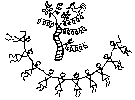 |
The government officials admitted that trees need more protection and promised to extend help and support to the students’ endeavours. |
|
Saving Our Trees |
|
The benevolent tree!! What
does it
get in return? How do we treat them? We at CLEAN-India tried to find out. Imagine yourself standing at a busy traffic intersection (say ITO at Delhi), 24 hours a day, 365 days a year -cars, buses and trucks spewing smoke and dust on your face; steel girders prisoning your body; stones and concrete poured around your feet to a depth of 30 to 40 cms; advertisements and nails pierced on your body! |
What is a tree? The plough for a farmer, Firewood in a village kitchen, Boat for a fisherman, Home for birds and animals, Food and shade, Oxygen supplier, Pollution abator, Soil preserver, Rain giver, Natural air conditioner, The breath of life……….. For Man! |
| According to the Greening Delhi Action Plan 2000-2001 report , in the year 1999-2000, nearly 22 lakh saplings of trees and shrubs were planted in Delhi. The target for 2000-2001 is 25,02,406 saplings to be planted by the horticultural wings of different govt. agencies like New Delhi Muncipal Council (NDMC), Muncipal Corporation of Delhi (MCD), Department of Environment (DoE) and the Forest Department. For the past decade, the numbers have been the same on an average. Even if 5% of these survived, Delhi should be completely covered with tree (green) cover! |
|
| It is a misconception that trees require great care only when they are young saplings. Studies have shown that even mature trees require care and attention for their survival. According to the findings of the Forest Research Institute, Dehradun the main reason for death of road side trees is the tiling and concretisation upto the trunk of these trees. Many big and beautiful trees of Neem and Imli, younger trees of Alistonia and Karanj on the Bhogal, Nizamuddin and Sundar Nagar stretch of Mathura Road are completely choked either by tiling or by tarring. The neem trees outside Rahim’s tomb are choked to death, needing immediate action. |
CLEAN-India organised tree surveys near a few schools in
Vasant Kunj, R.K.Puram and Saket areas in Delhi. The findings were alarming.
Most of the trees were under stress either due to tiling or tarring. In addition
to this, many were nailed for advertisements and also strangled by tree guards.
The trees seemed to cry out for immediate help. |
w
Non-adherence by various government departments to the government notification - though the government notification lists 23 issues regarding trees and other greens of our cities and towns, the concerned departments are not taking action on themw
Not getting responses from authorities - when the students report to the authorities regarding removal of tree guards/tiles, cutting of trees etc. in specific areas (supported by photographs), they neither get timely response nor required action.w
Information regarding the Tree Helpline - As many agencies (NDMC, MCD, DDA, PWD, CPWD) are involved in the care of trees and roadside pedestrian pathways, the students felt that if there could be one single authority who could be approached for necessary action. |
The government officials admitted that trees need more protection and promised to extend help and support to the students’ endeavours. |
Each step counts
Each and every CLEAN-India member is a tree ambassador and
has the responsibility of not only spreading awareness but also looking for
solutions and take suitable actions. What is needed is both advocacy and action.
Here are some of the initiatives that we can take as friends of trees:
1. Respect trees and plants and refrain from plucking leaves/ grass/flowers unnecessarily.
2. Do not burn the dried leaves under the trees, instead allow them to mulch.
|
3. When vehicles/ drive ways are washed, drain the waste
water towards a tree / plants nearby |
Prayer of the Tree the heat of your hearth, I screen you from the sun With friendly shade I give people fruits and flowers As you thirst, my fruits refresh you I am the beam that holds your house, The board of your table, The bed that you lie on The timber that builds your boat And from which you get furniture. I am the hands of your hoe, And the door of your homestead. The wood of your cradle and the shell Of your coffin. Samuel Alodina, Ghana Source: PACHAMAMA by UNEP and Peace Child Intl |
 |
|
|
|
9. Whenever you find trees being threatened, inform the
school authorities/ residents/ RWAs for action, or form your own youth group and
take first aid action for trees. |
By : Usha
Srinivasan
The author is a consultant of
CLEAN-India,
Development Alternatives